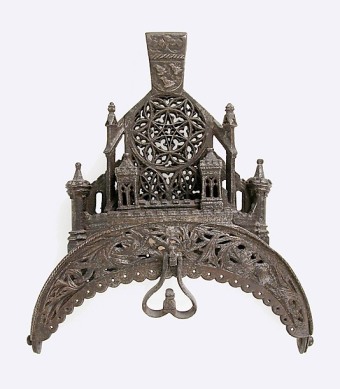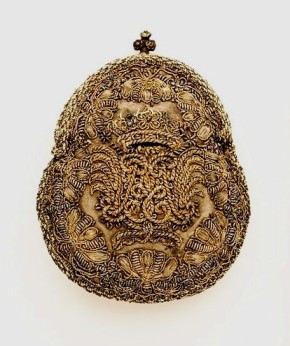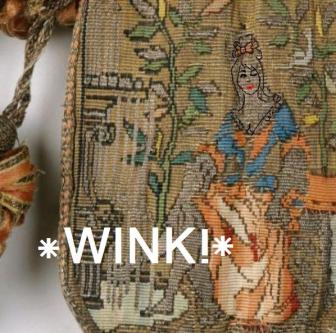15th-17th Century Purses

I don’t go anywhere without my cellphone, wallet, keys, lip balm, or mini Swiss Army knife. But where can I put it all when I’m in costume? Lugging around my modern purse while in historical costume looks beyond ridiculous and I can’t have Chris carrying everything…(that poor man, I always take advantage of the ample pockets in his cargo pants. Why do boys get more/deeper pockets than girls anyways? Girls have so much more stuff to carry!)
The solution? A historically accurate purse! When I was looking for a purse solution, I was surprised to learn what a wide variety history has to offer! There are so many designs to choose from and you’re sure to find one that perfectly suits your taste in any era! For example, if you need a Renaissance purse, look no further than the four-sided drawstring pouch. Don’t want to carry around an annoying clutch purse or deal with a satchel that keeps slipping off your shoulder? Four-sided pouches are the way to go! They have had long strings to tie around your waist directly or to string around a belt or girdle. The purse above is a very fine heraldic piece made around 1540. This purse wasn’t your run-of-the-mill coin purse, but a ceremonial piece that would have been carefully treasured, perhaps used as a dowry. With 1,250 silk stitches per square inch, it surely is a masterpiece! It took a very skilled seamstress many hours to finish it. Here’s another example of the four-sided pouch:

Since this purse was not a ceremonial piece, but a well-used coin purse, it shows a lot more wear, but the basic shape is what’s important. The four sides allow for plenty of interior space, but the purse can be folded flat when empty.
Drawstring purses were, by far, the most popular style of purse from about 1590 onwards. By the turn of the 17th century, flat, square purses came into style. Many of these purses were not for coins, but were “swete-bags,” filled with scented herbs to sweeten the air during a time when bathing and sewage disposal weren’t priorities. The 17th century was the era of the Baroque, a style which delighted in excess of decoration and trims. The purses of the late Renaissance and Jacobean eras reflect this taste for trims and are often coated in gilded thread, tassels, appliques, spangles (sequins), and ribbons.

Almost every drawstring purse during this era had hanging pomanders or covered wooden beads at the end of their strings to help tie it shut without the need of knots (so you wouldn’t look a fool when you untied your pouch. Just imagine the embarrassment of knotting your purse so tight you can’t open it!). They were rarely used for carrying money, but served as elaborate gift bags or as utility kits to carry glasses, pens, and sewing kits.

Another type of drawstring purse is the gambling purse. These purses are flat-bottomed and round like a bowl, specifically shaped so that they can sit open on a table filled with coins, counters, or other game pieces.


Gambling was a popular, socially acceptable form of entertainment in the late 17th century– provided you were wealthy enough not to work for a living. Gaming purses were often decorated with the family crest or lucky symbols to help the player keep track of his purse and maybe win a few extra turns as well! These gaming purses are often elaborately decorated, advertising the wealth of the owner, however some are rather plain. It all depended on the player’s strategy: brazenly display your wealth with an ornate purse or keep your true worth private with a plainer purse.

Drawstring pouches are pretty simple in principle and do not require frames like many modern purses and clutches do. You would think that framed purses are a later 19th or 20th century invention, but framed purses actually date back to Da Vinci’s time and beyond! The most beautiful and unusual historical purses actually come from the mid-Renaissance. Leonardo himself designed a purse around the turn of the 15th century:

The sketch is of an ornate handbag with a metal top. Two designers– Agnese Sabato and Alessandro Vezzosi– brought the bag to life, creating a surprisingly modern-looking handbag:

This bag, while modern in construction, is actually ancient in design and, in comparison to other purses from the 1500s, rather simple in design (as per Leonardo’s personal taste). Perhaps the most amazing purses of all time can be found way back in the 15th century. They are breathtaking! Many Renaissance purses were architectural wonders. For example, here’s a purse with an entire castle perched on the frame:

This is definitely a fairytale purse! The towers remind me of the Emerald City in the Wizard of Oz. Unlike modern purse frames which are mostly invisible, Renaissance purse frames were miniature masterpieces, often in the shape of castles, cities, or cathedrals:

Just like the real-life strongholds, these clasped frames alerted thieves that while the treasure inside the purse may be great, he’ll have a devil of a time getting at the contents. Some of these large purse frames had locking mechanisms inside and required a key to open (click here to check out the back side of the red velvet purse where you can see a keyhole)– pretty elaborate for something over 600 years old! Here’s my favorite Renaissance purse of all time, dating back to about 1470-1550:


If Snow White owned a purse, it had to be this one! Just look at how detailed and thick the frame is! On the back are two iron loops so it could be threaded onto a belt, keeping your treasures close at hand. It’s like a 15th century fanny pack, only infinitely more fashionable!
Sadly, as time wore on, purse frames scaled back in size and grandeur until they resembled modern purse frames:

Framed purses began to fall out of favor by the end of the 17th century and did not boom in popularity again until after the Industrial Revolution made manufacturing the metal frames much cheaper; however, all is not lost in the ornamentation department! While they’re not as architecturally impressive as the castle purses of the Renaissance, by 1680, purses were becoming as frilly and over-dressed as the courtiers that carried them!

The purse above features an adorable pair of Cupid-shot hearts along with glittery paste gems and loads of fluffy green tassels! There is no mistaking that rococo is hot on this purse’s heels! Purses weren’t just for the ladies either. If you were a gent back in 1690, you wouldn’t store your widgets in khaki cargo pants, but this naughty little purse, complete with a sexy 17th Century pin-up of a pretty lass showing off some leg!


After checking out all these incredible 15th-17th century purses, I have decided to add making one to my list. I know, I know, I’ve got a lot of projects to do already, but these little purses are seriously cool! And like shoes, no woman can have too many purses!
Click here to visit: Where Should I Put It? Part II
For those of us who costume between 1700 and 1800!

As with all my articles, all of the images in this article are either linked to larger versions, articles explaining them, or other fact-filled sites to help you explore, so please feel free to check them out!
Update:
I found this 17th century fashion plate by Jean Dieu de Saint-Jean entitled Recueil des modes de la cour de France, ‘Dame se Promenant a la Campaigne’, circa 1675-1677:

Doesn’t she look stunningly Victorian (and her shoes magnifique)? On her hip, you can see a large black bag which, on closer inspection, appears to have the shape and gathering pattern of a large velvet gaming purse, though I cannot be sure. It may be similar style, but would probably contain ladylike objects such as combs, needles, scissors, or handkerchiefs.























